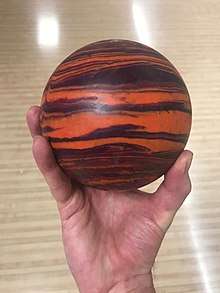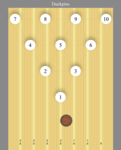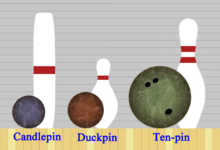Duckpin bowling
Duckpin bowling is a variation of the sport of bowling.
Duckpin balls are 4 3⁄4 in (12 cm) to 5 in (12.7 cm) in diameter, weigh 3 lb 6 oz (1.5 kg) to 3 lb 12 oz (1.7 kg) each, and lack finger holes. They are thus significantly smaller than those used in ten-pin bowling but are slightly larger and heavier than those used in candlepin bowling.
Duckpins, though arranged in a triangle identical to that used in ten-pin bowling, are shorter, slightly thinner, and lighter than their ten-pin equivalents, which makes it more difficult for the smaller ball to achieve a strike. For this reason, similar to candlepin bowling, the bowler is allowed three rolls per frame.
Rules
Duckpin bowling has rules[3] similar to ten-pin bowling. In a 10-frame game, bowlers try to knock down pins in the fewest rolls per frame. Bowlers have three balls per frame, instead of two as in ten-pin bowling, to knock over a set of 10 pins. If a bowler knocks down all 10 pins with their first roll in a frame, it is scored as a strike. If all the pins are knocked down in two rolls, the bowler has made a spare. If all the pins are knocked down in three rolls, it is scored as a ten, as in candlepins, with no bonus. If pins are still standing after the third ball, the bowler gets one point for each pin knocked down.
In the case of a strike, the bowler gets 10 points plus the total number of pins knocked down with the next two balls rolled, for a maximum of 30 points. In the case of a spare, the bowler gets 10 points plus the number of pins knocked down with the next ball, for a maximum of 20 points. If it takes three balls to knock down all 10 pins, the bowler gets 10 points, with no bonus. A bowler's final score is the sum of the points earned over 10 frames (a spare or strike in the tenth frame earns one or two rolls respectively). The maximum possible score of 300 points, which is accomplished by rolling 12 strikes in a row, has never been achieved under official conditions.
History
The origin of duckpin bowling has been disputed. A commonly recited assertion is that the sport began in Baltimore around 1900, at a bowling, billiards and pool hall owned by future baseball Hall of Famers John McGraw and Wilbert Robinson,[4] both of the old (1882–1899) Baltimore Orioles.[5] One such claim is reported in the Pittsburgh Press of March 3, 1929.[5] However, research has since found references to duckpin dating to the early 1890s in New Haven, Boston and Lowell, Mass.[4] Author Howard W. Rosenberg wrote in 2005 that his research showed the sport was around "at least as of 1894, and probably well before that",[6] with former Duckpin News editor Stacy Karten stating in a 2016 publication that Rosenberg found an 1892 reference to duckpin in The Boston Globe.[7]





Duckpins was not an organized sport until the National Duckpin Bowling Congress (NDBC) was founded in 1927.[13]
In 1953, submarine designer Ken Sherman developed the first automatic duckpin pinsetter, its design having over 1,000 moving parts.[4] Sherman's refusal to sell his patent to ten-pin competitor Brunswick caused him to lack corporate investment needed to manufacture large numbers of duckpin pinsetters.[14] Further, no parts for the Sherman pinsetter have been manufactured since 1973,[14] so that anyone wanting to open a new bowling center must cannibalize parts.[15] The absence of new pinsetter machines is thought to curtail growth of the sport, and spare parts must be scavenged or obtained from alleys that have closed.[4] Only one company makes duckpins, and it only leases them.[15]
The executive director of the National Duckpin Bowling Congress said in 2016 that there were 41 congress-certified duckpin bowling alleys, down from nearly 450 in 1963.[4] In comparison, there were about 4,000 ten-pin centers in 2018.[16] The Baltimore Sun reported in 2017 that the number of professional duckpin bowlers is down by more than 90 percent.[15]
In 1982, the Women's National Duckpin Association (WNDA) was formed, conducting tournaments for women to compete professionally,[17] with Ladies Professional Duckpin Tournament (LPDT) events extending back at least as early as 1974.[18]
Accomplishments and record scores
| No. Games in Set | Bowler's Name (men's category) |
Score | Avg Score / Game | Year | Bowler's Name (women's category) |
Score | Avg Score / Game | Year | ||
|---|---|---|---|---|---|---|---|---|---|---|
| 1 | Pete Signore Jr. | 279 | 279 | 1992 | Carole Gittings | 265 | 265 | 1973 | ||
| 3 | Jeff Pyles | 655 | 218 | 1978 | Diane Jasper | 586 | 195 | 1988 | ||
| 4 | Nappy Ranazzo | 758 | 189 | 1994 | Amy Bisson | 741 | 185 | 2005 | ||
| 5 | William Schwartz | 988 | 197 | 1988 | Amy Bisson Sykes | 882 | 176 | 2016 | ||
| 6 | James E. Deviers | 1116 | 186 | 1984 | Jill Manns | 1017 | 169 | 2013 | ||
| Season | Jeff Pyles | 164.47 | 164.47 | 1982-83 | Amy Bisson | 155.08 | 155.08 | 2005-06 |
In 1999, Sports Illustrated named Elizabeth "Toots" Barger among the fifty top Maryland athletes of all time, Barger having claimed thirteen NDBC No. 1 rankings for having the highest female duckpinner average.[7] Barger won nine world championships, and, in 1961, became the second woman to be inducted into the Maryland Athletic Hall of Fame.[21]
Variants
Rubber band duckpins

In 1905 a variant called rubber band duckpins was introduced in the Pittsburgh, Pennsylvania area by William Wuerthele,[23] in which the pins are circled with hard rubber bands to increase action and scoring. Wuerthele observed bowlers wasting their third ball as well as flying pins injuring pin boys, so, according to a defunct publication called The Ducks, Wuerthele added the rubber band to increase scoring.
The American Duckpin Congress was formed in the 1920s to govern the game of rubber band duckpins. The organization later became the American Rubber Band Duckpin Bowling Congress in 1945 and became an affiliate of the National Duckpin Bowling Congress. The rubber band game is now almost extinct, with most of the lanes located in private clubs, though there is one alley in the U.S. still open to the public in Glassport, Pennsylvania.
As of 2018, rubber band duckpins was mostly limited to Québec, where it is called petites quilles.[24]
There have been perfect games bowled in rubber band duckpin, including the largest duckpin prize ever won on television, C$50,000 in 1994.[25] Since it is easier to knock down pins in rubber band duckpin, its rules are identical to those of ten-pin bowling.
Compared to ten-pin bowling
The USBC reported that there were 55,266 certified 300 games in ten-pin bowling in the 2013-14 season alone, but there has never been a certified 300 game in duckpin bowling.[4] A Connecticut man named Pete Signore Jr. came closest with a 279 game in 1992.[4]
References
- "National Duckpin Bowling Congress / Official Site". National Duckpin Bowling Congress (NDBC). Archived from the original on May 9, 2019. Retrieved May 10, 2019.
- Powers, Joy (March 16, 2018). "Think You've Been Duckpin Bowling in Milwaukee? Think Again". WUWM.com. Milwaukee public radio. Archived from the original on November 28, 2018.
- "Rule Book/ Directory" (PDF). ndbc.org. National Duckpin Bowling Congress. September 1, 2014. Archived (PDF) from the original on August 21, 2018.
- Barry, Dan (May 26, 2016). "The Lost Art of Duckpin Bowling". The New York Times. Archived from the original on August 26, 2016.
- Turbyville, Fred (March 3, 1929). "Wilbert Robinson Claims He Invented Duckpins / 'Uncle Robby' Gave Shaved Down Tenpins Their Present Name / Looked Like Duck / Game Has Big Hold in East, Now As Well In Pittsburgh". The Pittsburgh Press. p. 43. Archived from the original on May 9, 2019. Accessed through Google News website.
- Rosenberg, Howard W. (August 2005). "Letter to the editor (of source magazine)" (PDF). Baltimore SmartCEO. Archived (PDF) from the original on May 9, 2019. Magazine PDF published on Venable.com.
- Karten, Stacy (2016). "10 / Toots Barger / Queen of Duckpins". In Nathan, Daniel A. (ed.). Baltimore Sports / Stories From Charm City (PDF). University of Arkansas Press. pp. 129–140. Archived (PDF) from the original on May 11, 2019.
- "Oxford Club of Lynn / Bowling Fever Has Struck the City and Some Good Talent Being Developed". The Boston Daily Globe. January 2, 1893. Archived from the original on May 10, 2019.Vol. XLIII, No. 2.
- "Candlepin Bowling / Seems to Be Growing in Favor With the Men Who Want a Scientific Game". The Boston Post. December 16, 1893. p. 6. Archived from the original on May 9, 2019. Describes "duck pins", "the swan", and "the midget" in the context of candlepins.
- "Bowling News". The Lowell Daily Sun. Lowell, Massachusetts. May 19, 1894. p. 35. Archived from the original on May 9, 2019. Vol. XXII, No. 69.
- "Kansas Sporting Notes". The Topeka State Journal. May 1, 1895. Archived from the original on May 6, 2019. Accessed via the U.S. Library of Congress online.
- "Duck Pin Contest / TAA and YMCA to Bowl - TAA Preparing". The Topeka State Journal. December 13, 1897. p. 8. Archived from the original on May 6, 2019. Accessed via the U.S. Library of Congress online.
- Kalman, Victor (February 28, 1955). "Small Pins / Duck Pins Are Little, But They're a Challenge Even to Big Pin Fans". Sports Illustrated. Archived from the original on May 9, 2019.
- Lennon, Beth (November 22, 2017). "Vintage bowling: Duckpins, candlepins roll on". USA Today. Archived from the original on December 4, 2017.
- Kaltenbach, Chris (March 2, 2017). "Small pins, big hopes: With duckpin bowling, longstanding Baltimore tradition hopes for a resurgence". The Baltimore Sun. Archived from the original on July 26, 2018.
- Data: Wayback Machine archives of USBC's bowl.com website. Links provided on Wikimedia's image page (2019-04-03 archive thereof)
- "History of Duckpins". APIbowling.com. American Products, Inc. (pin manufacturer). 2015. Archived from the original on February 19, 2019. Publication date is estimated based on earliest Wayback Machine archive.
- "Past Tours". WNDAtour.com. Womens National Duckpin Association. Archived from the original on April 22, 2019. Accessed in 2019; presumably page is updated annually.
- "Men's World Records / Updated as of March 2006 / Men's Individual". National Duckpin Bowling Congress (NDBC). March 2006. Archived from the original on October 28, 2017.
- "Women's World Records / Updated as of July 2016 / Women's Individual". National Duckpin Bowling Congress (NDBC). July 2016. Archived from the original on May 8, 2019.
- Levy, Claudia (September 30, 1998). "Elizabeth Barger, Duckpin Bowling Champion, Dies at 85". The Washington Post. Archived from the original on August 7, 2020.
- U.S. Patent 1,114,078, Stanley, Richard E., "Bowling Pin", issued June 22, 1915
- Historical Dictionary of Bowling (2014) by John Grasso and Eric R. Harman
- Serven, Neil (January 5, 2018). "Halfway Back to Worcester /". TheSmartSet.com. Archived from the original on June 17, 2018.
- "Quilles G plus". 2007-03-21. Archived from the original on 2007-04-02.
- The Ducks Magazine, October 1928, Pittsburgh Pennsylvania
External links
- National Duckpin Bowling Congress (NDBC) (archive)
- The Duckpin News list of duckpin proprietors (archive)




